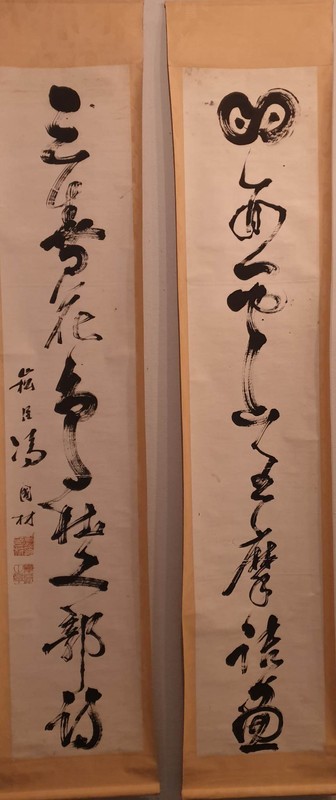Couplet (Left)
Introduction
Text-to-speech Audio
- Paintings of mountains surrounding by clouds and fog like the painting of Jiemo Wang, poetry about spring, birds, flowers like Fu Du’s poetry
- What you see is a pair of couplets in cursive script, written for Mr. Feng Guocai, donated to our museum by Ms. Helen Kong.
Images

Backstory and Context
Author-Uploaded Audio
Listen to a narration of this entry's description by Cultural Chinese.
Text-to-speech Audio
- This is a "gift couplet" created to honour others. The couplet is used to praise and show admiration for others. The couplet expresses that the receiver’s literary achievement is so high that it is comparable to famous poets Wei Wang and Fu Du. Wei Wang was greatly influenced by Zen Buddhism, famous for his versatile talents for poetry, calligraphy, and painting. He invented ink and wash painting. Fu Du, together with the other famous poet Bai Li, were called “Li Du”. Fu Du was respectfully called “the saint of poetry”, also “the history of poetry” due to his significant social and historical achievement.
- Because the works are written in cursive script, the style is unrestrained and elegant, the artistic conception is elegant and ethereal, and the brushwork and lines are full of rhythm so that the viewer can feel the tension and fluency of continuity. Maybe people generally think that cursive couplets are difficult to read, but if you really don’t know them, you don’t need to worry about them. We can appreciate the elusive lines of calligraphy handwriting, which is not bad! The beauty is not rigid, but chic and flexible
- The couplet is one of the unique literary forms in China. Its wonderful combination with calligraphy has become a colorful artistic originality of the Chinese nation. Couplets are commonly known as pairs. It is simple in language and deep in meaning, neat in antithesis, and harmonious in level and oblique. It is a unique art form of the Chinese language with 1 word and 1 sound. It can be said that the art of couplets is a cultural treasure of the Chinese nation. It is a pity that fewer and fewer people hang couplets in our family rooms now. About 50 years ago, couplets were hung in the homes of personnel, sages, officials, and businessmen, which are both elegant and beautiful.
- The popularity and prosperity of the couplet and its combination with the art of calligraphy have directly affected all things related to culture in the land of China. Chinese calligraphy is profound, with endless charm. Varies, 5-character and 7-character verses and 8-character sentences are the most common, covering rich content, including poems, aphorisms, proverbs and even colloquial Chinese.
- Throughout the ages, calligraphers like to use couplets to reciprocate gifts and literati also like to hang couplets in their living rooms. The couplets placed in the living room mainly have 2 functions, one is the function of education and culture, and the other is the function of social communication. Therefore, the living room couplets must first reflect the cultural accomplishment of the owner, and secondly, the appreciation level of the visitors should be taken into consideration, and the style and aesthetic feeling of the couplets should be considered. I wonder if you would consider hanging a pair of couplets at home after listening to this introduction?
